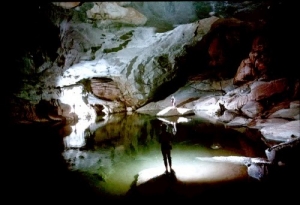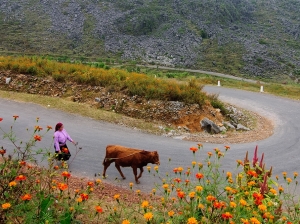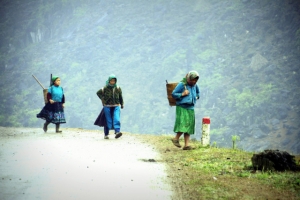Mong Ethnic Festival in Ha Giang
A cultural festival of the Mong ethic minority group took place in Meo Vac District in the northernmost province of Ha Giang on 22 February.
The special event, which aimed to preserve and display the cultural values and mysteries of the Mong's customs and habits at Dong Van Plateau, attracted a great number of visitors.
"After the success of the first cultural festival of the Mong group last year, this year's event hoped to build a Vietnamese culture filled with national identities as well as to promote tourism," Nguyen Cao Cuong, chairman of Meo Vac District people's committee, said.
Visitors who love to explore cultural values got a chance to take part in many unique activities such as Gau Tao festival and Khen (a wind instrument) dancing festival, and to learn and experience traditional crafts, besides enjoying folk games such as tug of war and goat fights.
This year's festival featured more than 500 artisans, local actors and athletes from 18 communes of Meo Vac District.
Source: VNS
Peaceful Tha Village in Ha Giang
Quiet, authentic, picturesque – Tha village is well known among tourists for its charm and peaceful beauty. Located just 2km from Ha Giang, Tha village stands out for its stilt houses, green bamboo groves and lush rice fields.
Tha village offers a gentle beauty far from the urban hubbub. The murmur of limpid streams and a flirting wind in the palms welcome you at the village entrance. Then you enter a mysteriously region submerged all year round in a mist, a lush forest floor, where centuries-old values are still present. Here you will come across no trace of modernity, no multi-storey buildings, and no vehicles. Nguyen Van Nhuong lives in the village: "I prefer the wooden houses on stilts to concrete housing. Building a house on stilts costs about 300 million VND but it's worth it because it is very comfortable and airy throughout the year. "

Here in the village you can take an actual breath of fresh air and enjoy the warm hospitality of the people. The Tay people are very warm and welcoming. If a stranger invites you to drink a cup of tea or offers her prettiest smile, do not be surprised.
Tay people still weave brocade products like bags, scarves, skirts, and pants. For a closer experience of Tay life, spend a night with the locals.
In addition to a taste of their corn alcohol, you will have the chance to savor their many culinary specialties: fish with fermented bamboo shoots, chicken salad, grilled pork with bamboo and wild vegetables. The Tay cook very well. Mai Thi Chung lives in Tha village: “Tourists are impressed by our hospitality and the customs we fiercely preserve over time. We offer our best recipes to tourists. We grill meat on the pan - our best dishes served at Tay parties. These dishes are prepared using lots of special spices, such as cardamom, basil, pepper, and shrimp paste”.
After dinner, tourists can experience Then singing, the intangible heritage all generations of Tay perpetuate. A singer improvises lyrics of his song while playing a kind of guitar called a Tinh other while artists perform graceful dances. Everything is in harmony like a painting of life in paradise.
Source: VOVworld
Na Luong cave in Ha Giang recognised as national site
Stretching over the area of Mau Long commune, Yen Minh district and Sung Trai commune, Dong Van district, the cave was discovered by scientists in 2010 and is considered the most beautiful cave to be unearthed in Ha Giang so far.
The cave was formed in limestone, which is a common geological tendency across the Dong Van Krast Plateau in Ha Giang—a UNESCO-recognised Geo-Park.
The entrance to the cave, 30 metres in width, is covered with many valuable timbers. The inside of the cave amazes visitors with many stunning stalactites in various shapes and colours, which have been formed over thousands of years.
According to Secretary of the Yen Minh district Party Committee, Hoang Van Vinh, the district authorities have taken measures to safeguard the pristine beauty of the cave and raise public awareness of visitors and ethnic minority groups on protecting its surrounding ecological environment.
Efforts have also been made to advertise the image of the cave, making it an attractive destination for tourists to Ha Giang, he said.
Flowers season in Ha Giang
Ha Giang in early winter is not only dreariness pink of flowers triangular circuit but also bought the indescribable wistfully feeling and colorful flowers around many slopes. Therefore, travelers who first time come to here, will get lost in and dont't want to come back home.
Passing the flowers season in curve slopes, crooked of border area of China, the roadside flower colors make the journey becomes shorter. The brilliant colors of flowers around the spectacular mountains like the warm smile of people here.
Ha Giang in November bought to visitors the poetic beauty from the idyllic scenes and dearest.








Stunning at Ma Pi Leng pass in Ha Giang

Passing through: Ma Pi Leng Pass is one of the highest passes in the country.
Ma Pi Leng Pass, also called the Great Wall of Viet Nam, is one of the four highest passes in the country, alongside Khau Pha in Yen Bai Province, O Quy Ho in Lao Cai Province and Pha Din in Lai Chau Province.
The pass is located in the globally recognised geological park Dong Van. It is not long, only 20km, but dangerously steep cliffs and deep mountainous slopes make the path difficult.
The pass's name literally means "nose of the horse". But figuratively, it means the mountain is difficult to access and riddled with obstacles – it's as vertical as a horse's nose.
On the way to Ma Pi Leng, we met children walking along the road. They liked watching visitors, and seemed glad when we gave them cakes, candies and scarves.
Sometimes on the side of the roads we saw small pubs that brought a wild beauty to the place. Some H'Mong men got tipsy and sat nodding by the roadside.
When we took in the view from the peak of Ma Pi Leng, mist covered the whole trail. We had never seen it look so mysterious before. It looked like paradise.
The pass's majestic and wild beauty makes it unique.
As we looked to the north and northeast, we saw thousands of grey mountains spreading up toward the horizon.

Ma Pi Leng pass and Nho Que river
Next to the path lied a chasm, and below us the Nho Que River ran like a colourful thread through the cliffs.
The H'Mong people's houses, surrounded by stone fences, perched on the edge of the chasm.
Some of the houses' walls were made of neohouzeaua, a kind of bamboo, which remained sturdy despite the region's wind and rain.
The Ma Pi Leng area was named a national sightseeing by the Ministry of Culture, Sports and Tourism on November 16, 2009.
According to the ministry's decision, Ma Pi Leng Pass is considered a special heritage area.
Ma Pi Leng's mountain top is one of the most beautiful observation points in Viet Nam, and Nho Que river's alley is one of the most unique tectonic valleys in Viet Nam.
Historical road
In addition to beauty, a history of volunteer youths building roads memorialises the Ma Pi Leng area.
The 185km road that goes to Ma Pi Leng Pass is called Hanh Phuc (happiness). It runs from Ha Giang City to Meo Vac District. It connects isolated mountainous districts and helps ethnic minorities access the plains.
Thousands of young people from 16 ethnic minority groups built the road between 1959 and 1965.
They had to string themselves up on the rock cliffs to make it through the dangerous 11-month building process.
At the beginning, the pass was only wide enough for pedestrians and horse-drawn carts. Later, it was widened so cars and vans could use it.
At the peak of Ma Pi Leng Pass and at the highest point of Hanh Phuc Road, we stopped to take photos of Nho Que river, enjoying a thrilling feeling. We also saw an old stone stele used for marking lengths during the pass's construction.

Hanh Phuc Road
It took the previous generation six years to make Hanh Phuc Road.
About 11 months of that time was spent making the 20km pass over Ma Pi Leng. But it took us only one day and one hour to trek across both. A feeling of admiration for the builders overwhelmed us.
The road instills happiness in ethnic minorities and visitors who have the chance to go and contemplate the country's boundless beauty.










































































































